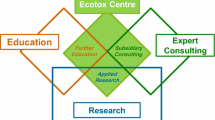Abstract
The assessment of impacts of chemically contaminated aquatic environments on animal systems has a number of shortcomings. These include problems with analyses for toxic chemicals and the relevance of bioassays for predicting risk to ecosystems. Research is urgently needed to find better ways to solve these problems, particularly with respect to chronic exposures.
Similar content being viewed by others
References
Buhler, D. R. & D. E. Williams, 1988. The role of biotransformation in the toxicity of chemicals. Aquat. Toxicol. 11, 19–28.
Chapman, P. M., 1986. Sediment quality criteria from the sediment quality triad: An example, Envir. Toxicol. Chem., 5, 957–964.
Daly, H. B., D. R. Hertzler & D. M. Sargent. Ingestion of environmentally contaminated Lake Ontario salmon by laboratory rats increases the avoidance of unpredictable aversive non-reward and mild electric shock, Behavioral Neuroscience, 1989 (in press).
Draft report, Everett Harbor Action Program: Analysis of toxic problem areas, May 1988, Prepared for U.S. Environmental Protection Agency, Region X, Office of Puget Sound, Seattle, Washington (TC-3338-26), pp. 44–58.
Farber, E. & R. Cameron, 1980. The sequential analysis of cancer development. Adv. Cancer Res. 31: 125–226.
Fein, G. G., S. W. Jacobson, P. W. Schwartz & J. K. Fowler, 1984. Prenatal exposure to polychlorinated biphenyls: Effects on birth size and gestational age, Pediatr., 105: 213–220.
Hardy, J. T., E. A. Crecelius, E. Long, S. L. Kiesser, A. I. Stubin, J. M. Gurtisen & C. W. Apts, 1987. Contamination and toxicity of the sea-surface microlayer of Puget Sound, R. H. Gray, E. K. Chess, P. J. Mellinger, R. G. Riley and D. L. Springer (Eds), Health and Environmental Research on Complex Organic Mixtures, U.S. Department of Energy Symposium Series 62, pp. 643–655.
Hertzler, D. R., 1983. Behavioral evaluation of neurotoxic effects caused by the consumption of Lake Ontario salmon. Pap. pres. Eastern Psychological Assoc. Meeting, Philadelphia, PA.
Jacobson, J. L., S. W. Jacobson, P. W. Schwartz & J. K. Dowler, 1984. Prenatal exposure to an environmental toxin: A test of the multiple effects model., Dev. Psychol. 20: 523–532.
Malins, D. C., M. S. Krahn, M. S. Myers, M. L. Rhodes, D. W. Brown, C. A. Krone, B. B. Chain & S.-L. Chan, 1985. Toxic chemicals in sediments and biota from a creosote-polluted harbor; relationships with hepatic neoplasms and other hepatic lesions in English sole (Paraphrys vetulus), Carcinogenesis, 6: 1463–1469.
Malins, D. C., B. B. McCain, M. S. Myers, D. W. Brown & S.-L. Chan, 1983. Liver diseases in bottom fish from Everett Harbor, Washington, Coastal Ocean Assessment News, 2: 41–42.
Malins, D. C., B. B. McCain, M. S. Myers, D. W. Brown, M. M. Krahn, W. T. Roubal, M. H. Schiewe, J. T. Landahl & S.-L. Chan, 1987. Field and laboratory studies of the etiology of liver neoplasms in marine fish from Puget Sound, Envir. Health Persp. 71: 5–16.
McDowell Capuzzo, J., M. N. Moore & J. Widdows, 1988. Effects of toxic chemicals in the marine environment: Predications of impacts from laboratory studies, Aquatic Toxicol. 11: 303–311.
Memorandum Decision, No. C-88-380R, Barbara J. Rothstein, Chief United States District Judge, Seattle, Washington, August 11, 1988. pp. 1–87.
Reijnders, P. J. H., 1986. Reproductive failure in common seals feeding on fish from polluted coastal waters. Nature 324: 456–457.
Varanasi, U., W. L. Reichert & J. E. Stein, 1989. 32P-post-labeling analysis of DNA adducts in liver of wild English sole (Parophrys vetulus) and winter flounder (Pseudopleuronectes americanus), Cancer Res. 49: 1171–1177.
Author information
Authors and Affiliations
Rights and permissions
About this article
Cite this article
Malins, D.C. The use of environmental assays for impact assessment. Hydrobiologia 188, 87–91 (1989). https://doi.org/10.1007/BF00027774
Issue Date:
DOI: https://doi.org/10.1007/BF00027774




